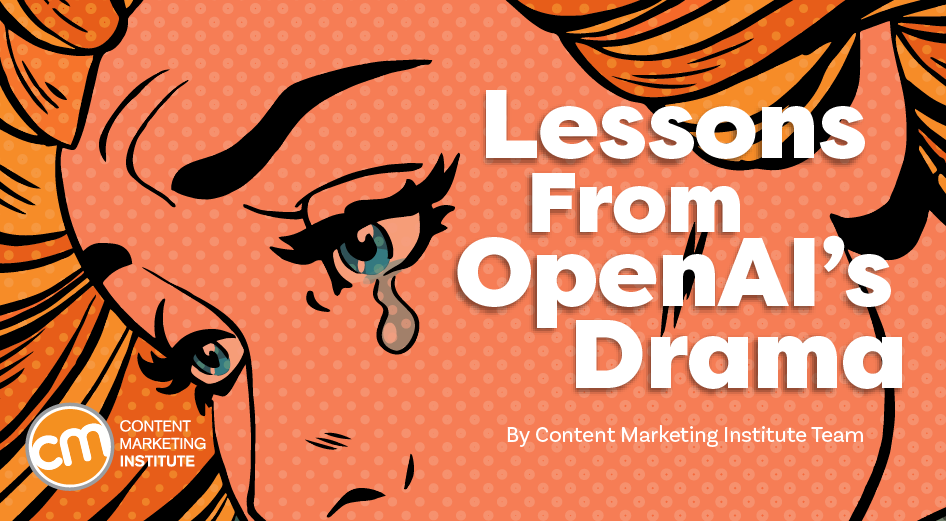MARKETING
OpenAI’s Drama Should Teach Marketers These 2 Lessons

A week or so ago, the extraordinary drama happening at OpenAI filled news feeds.
No need to get into all the saga’s details, as every publication seems to have covered it. We’re just waiting for someone to put together a video montage scored to the Game of Thrones music.
But as Sam Altman takes back the reigns of the company he helped to found, the existing board begins to disintegrate before your very eyes, and everyone agrees something spooked everybody, a question arises: Should you care?
Does OpenAI’s drama have any demonstrable implications for marketers integrating generative AI into their marketing strategies?
Watch CMI’s chief strategy advisor Robert Rose explain (and give a shoutout to Sutton’s pants rage on The Real Housewives of Beverly Hills), or keep reading his thoughts:
For those who spent last week figuring out what to put on your holiday table and missed every AI headline, here’s a brief version of what happened. OpenAI – the huge startup and creator of ChatGPT – went through dramatic events. Its board fired the mercurial CEO Sam Altman. Then, the 38-year-old entrepreneur accepted a job at Microsoft but returned to OpenAI a day later.
We won’t give a hot take on what it means for the startup world, board governance, or the tension between AI safety and Silicon Valley capitalism. Rather, we see some interesting things for marketers to put into perspective about how AI should fit into your overall content and marketing plans in the new year.
Robert highlights two takeaways from the OpenAI debacle – a drama that has yet to reach its final chapter: 1. The right structure and governance matters, and 2. Big platforms don’t become antifragile just because they’re big.
Let’s have Robert explain.
The right structure and governance matters
OpenAI’s structure may be key to the drama. OpenAI has a bizarre corporate governance framework. The board of directors controls a nonprofit called OpenAI. That nonprofit created a capped for-profit subsidiary – OpenAI GP LLC. The majority owner of that for-profit is OpenAI Global LLC, another for-profit company. The nonprofit works for the benefit of the world with a for-profit arm.
That seems like an earnest approach, given AI tech’s big and disruptive power. But it provides so many weird governance issues, including that the nonprofit board, which controls everything, has no duty to maximize profit. What could go wrong?
That’s why marketers should know more about the organizations behind the generative AI tools they use or are considering.
First, know your providers of generative AI software and services are all exploring the topics of governance and safety. Microsoft, Google, Anthropic, and others won’t have their internal debates erupt in public fireworks. Still, governance and management of safety over profits remains a big topic for them. You should be aware of how they approach those topics as you license solutions from them.
Second, recognize the productive use of generative AI is a content strategy and governance challenge, not a technology challenge. If you don’t solve the governance and cross-functional uses of the generative AI platforms you buy, you will run into big problems with its cross-functional, cross-siloed use.
Big platforms do not become antifragile just because they’re big
Nicholas Taleb wrote a wonderful book, Antifragile: Things That Gain From Disorder. It explores how an antifragile structure doesn’t just withstand a shock; it actually improves because of a disruption or shock. It doesn’t just survive a big disruptive event; it gets stronger because of it.
It’s hard to imagine a company the size and scale of OpenAI could self-correct or even disappear tomorrow. But it can and does happen. And unfortunately, too many businesses build their strategies on that rented land.
In OpenAI’s recent case, the for-profit software won the day. But make no bones about that victory; the event wasn’t good for the company. If it bounces back, it won’t be stronger because of the debacle.
With that win on the for-profit side, hundreds, if not thousands, of generative AI startups breathed an audible sigh of relief. But a few moments later, they screamed “pivot” (in their best imitation of Ross from Friends instructing Chandler and Rachel to move a couch.)
They now realize the fragility of their software because it relies on OpenAI’s existence or willingness to provide the software. Imagine what could have happened if the OpenAI board had won their fight and, in the name of safety, simply killed any paid access to the API or the ability to build business models on top of it.
The last two weeks have done nothing to clear the already muddy waters encountered by companies and their plans to integrate generative AI solutions. Going forward, though, think about the issues when acquiring new generative AI software. Ask about how the vendor’s infrastructure is housed and identify the risks involved. And, if OpenAI expands its enterprise capabilities, consider the implications. What extra features will the off-the-shelf solutions provide? Do you need them? Will OpenAI become the Microsoft Office of your AI infrastructure?
Why you should care
With the voluminous media coverage of Open AI’s drama, you likely will see pushback on generative AI. In my social feeds, many marketers say they’re tired of the corporate soap opera that is irrelevant to their work.
They are half right. What Sam said and how Ilya responded, heart emojis, and how much the Twitch guy got for three days of work are fodder for the Netflix series sure to emerge. (Robert’s money is on Michael Cera starring.)
They’re wrong about its relevance to marketing. They must be experiencing attentional bias – paying more attention to some elements of the big event and ignoring others. OpenAI’s struggle is entertaining, no doubt. You’re glued to the drama. But understanding what happened with the events directly relates to your ability to manage similar ones successfully. That’s the part you need to get right.
HANDPICKED RELATED CONTENT:
Cover image by Joseph Kalinowski/Content Marketing Institute
MARKETING
YouTube Ad Specs, Sizes, and Examples [2024 Update]
![YouTube Ad Specs, Sizes, and Examples [2024 Update] YouTube Ad Specs, Sizes, and Examples](https://articles.entireweb.com/wp-content/uploads/2024/06/YouTube-Ad-Specs-Sizes-and-Examples.jpg)
Introduction
With billions of users each month, YouTube is the world’s second largest search engine and top website for video content. This makes it a great place for advertising. To succeed, advertisers need to follow the correct YouTube ad specifications. These rules help your ad reach more viewers, increasing the chance of gaining new customers and boosting brand awareness.
Types of YouTube Ads
Video Ads
- Description: These play before, during, or after a YouTube video on computers or mobile devices.
- Types:
- In-stream ads: Can be skippable or non-skippable.
- Bumper ads: Non-skippable, short ads that play before, during, or after a video.
Display Ads
- Description: These appear in different spots on YouTube and usually use text or static images.
- Note: YouTube does not support display image ads directly on its app, but these can be targeted to YouTube.com through Google Display Network (GDN).
Companion Banners
- Description: Appears to the right of the YouTube player on desktop.
- Requirement: Must be purchased alongside In-stream ads, Bumper ads, or In-feed ads.
In-feed Ads
- Description: Resemble videos with images, headlines, and text. They link to a public or unlisted YouTube video.
Outstream Ads
- Description: Mobile-only video ads that play outside of YouTube, on websites and apps within the Google video partner network.
Masthead Ads
- Description: Premium, high-visibility banner ads displayed at the top of the YouTube homepage for both desktop and mobile users.
YouTube Ad Specs by Type
Skippable In-stream Video Ads
- Placement: Before, during, or after a YouTube video.
- Resolution:
- Horizontal: 1920 x 1080px
- Vertical: 1080 x 1920px
- Square: 1080 x 1080px
- Aspect Ratio:
- Horizontal: 16:9
- Vertical: 9:16
- Square: 1:1
- Length:
- Awareness: 15-20 seconds
- Consideration: 2-3 minutes
- Action: 15-20 seconds
Non-skippable In-stream Video Ads
- Description: Must be watched completely before the main video.
- Length: 15 seconds (or 20 seconds in certain markets).
- Resolution:
- Horizontal: 1920 x 1080px
- Vertical: 1080 x 1920px
- Square: 1080 x 1080px
- Aspect Ratio:
- Horizontal: 16:9
- Vertical: 9:16
- Square: 1:1
Bumper Ads
- Length: Maximum 6 seconds.
- File Format: MP4, Quicktime, AVI, ASF, Windows Media, or MPEG.
- Resolution:
- Horizontal: 640 x 360px
- Vertical: 480 x 360px
In-feed Ads
- Description: Show alongside YouTube content, like search results or the Home feed.
- Resolution:
- Horizontal: 1920 x 1080px
- Vertical: 1080 x 1920px
- Square: 1080 x 1080px
- Aspect Ratio:
- Horizontal: 16:9
- Square: 1:1
- Length:
- Awareness: 15-20 seconds
- Consideration: 2-3 minutes
- Headline/Description:
- Headline: Up to 2 lines, 40 characters per line
- Description: Up to 2 lines, 35 characters per line
Display Ads
- Description: Static images or animated media that appear on YouTube next to video suggestions, in search results, or on the homepage.
- Image Size: 300×60 pixels.
- File Type: GIF, JPG, PNG.
- File Size: Max 150KB.
- Max Animation Length: 30 seconds.
Outstream Ads
- Description: Mobile-only video ads that appear on websites and apps within the Google video partner network, not on YouTube itself.
- Logo Specs:
- Square: 1:1 (200 x 200px).
- File Type: JPG, GIF, PNG.
- Max Size: 200KB.
Masthead Ads
- Description: High-visibility ads at the top of the YouTube homepage.
- Resolution: 1920 x 1080 or higher.
- File Type: JPG or PNG (without transparency).
Conclusion
YouTube offers a variety of ad formats to reach audiences effectively in 2024. Whether you want to build brand awareness, drive conversions, or target specific demographics, YouTube provides a dynamic platform for your advertising needs. Always follow Google’s advertising policies and the technical ad specs to ensure your ads perform their best. Ready to start using YouTube ads? Contact us today to get started!
MARKETING
Why We Are Always ‘Clicking to Buy’, According to Psychologists

Amazon pillows.
MARKETING
A deeper dive into data, personalization and Copilots

Salesforce launched a collection of new, generative AI-related products at Connections in Chicago this week. They included new Einstein Copilots for marketers and merchants and Einstein Personalization.
To better understand, not only the potential impact of the new products, but the evolving Salesforce architecture, we sat down with Bobby Jania, CMO, Marketing Cloud.
Dig deeper: Salesforce piles on the Einstein Copilots
Salesforce’s evolving architecture
It’s hard to deny that Salesforce likes coming up with new names for platforms and products (what happened to Customer 360?) and this can sometimes make the observer wonder if something is brand new, or old but with a brand new name. In particular, what exactly is Einstein 1 and how is it related to Salesforce Data Cloud?
“Data Cloud is built on the Einstein 1 platform,” Jania explained. “The Einstein 1 platform is our entire Salesforce platform and that includes products like Sales Cloud, Service Cloud — that it includes the original idea of Salesforce not just being in the cloud, but being multi-tenancy.”
Data Cloud — not an acquisition, of course — was built natively on that platform. It was the first product built on Hyperforce, Salesforce’s new cloud infrastructure architecture. “Since Data Cloud was on what we now call the Einstein 1 platform from Day One, it has always natively connected to, and been able to read anything in Sales Cloud, Service Cloud [and so on]. On top of that, we can now bring in, not only structured but unstructured data.”
That’s a significant progression from the position, several years ago, when Salesforce had stitched together a platform around various acquisitions (ExactTarget, for example) that didn’t necessarily talk to each other.
“At times, what we would do is have a kind of behind-the-scenes flow where data from one product could be moved into another product,” said Jania, “but in many of those cases the data would then be in both, whereas now the data is in Data Cloud. Tableau will run natively off Data Cloud; Commerce Cloud, Service Cloud, Marketing Cloud — they’re all going to the same operational customer profile.” They’re not copying the data from Data Cloud, Jania confirmed.
Another thing to know is tit’s possible for Salesforce customers to import their own datasets into Data Cloud. “We wanted to create a federated data model,” said Jania. “If you’re using Snowflake, for example, we more or less virtually sit on your data lake. The value we add is that we will look at all your data and help you form these operational customer profiles.”
Let’s learn more about Einstein Copilot
“Copilot means that I have an assistant with me in the tool where I need to be working that contextually knows what I am trying to do and helps me at every step of the process,” Jania said.
For marketers, this might begin with a campaign brief developed with Copilot’s assistance, the identification of an audience based on the brief, and then the development of email or other content. “What’s really cool is the idea of Einstein Studio where our customers will create actions [for Copilot] that we hadn’t even thought about.”
Here’s a key insight (back to nomenclature). We reported on Copilot for markets, Copilot for merchants, Copilot for shoppers. It turns out, however, that there is just one Copilot, Einstein Copilot, and these are use cases. “There’s just one Copilot, we just add these for a little clarity; we’re going to talk about marketing use cases, about shoppers’ use cases. These are actions for the marketing use cases we built out of the box; you can build your own.”
It’s surely going to take a little time for marketers to learn to work easily with Copilot. “There’s always time for adoption,” Jania agreed. “What is directly connected with this is, this is my ninth Connections and this one has the most hands-on training that I’ve seen since 2014 — and a lot of that is getting people using Data Cloud, using these tools rather than just being given a demo.”
What’s new about Einstein Personalization
Salesforce Einstein has been around since 2016 and many of the use cases seem to have involved personalization in various forms. What’s new?
“Einstein Personalization is a real-time decision engine and it’s going to choose next-best-action, next-best-offer. What is new is that it’s a service now that runs natively on top of Data Cloud.” A lot of real-time decision engines need their own set of data that might actually be a subset of data. “Einstein Personalization is going to look holistically at a customer and recommend a next-best-action that could be natively surfaced in Service Cloud, Sales Cloud or Marketing Cloud.”
Finally, trust
One feature of the presentations at Connections was the reassurance that, although public LLMs like ChatGPT could be selected for application to customer data, none of that data would be retained by the LLMs. Is this just a matter of written agreements? No, not just that, said Jania.
“In the Einstein Trust Layer, all of the data, when it connects to an LLM, runs through our gateway. If there was a prompt that had personally identifiable information — a credit card number, an email address — at a mimum, all that is stripped out. The LLMs do not store the output; we store the output for auditing back in Salesforce. Any output that comes back through our gateway is logged in our system; it runs through a toxicity model; and only at the end do we put PII data back into the answer. There are real pieces beyond a handshake that this data is safe.”
-

 SEO7 days ago
SEO7 days agoGoogle’s Revamped Documentation Shows 4 Reasons To Refresh Content
-
SEARCHENGINES5 days ago
Daily Search Forum Recap: August 26, 2024
-

 SEARCHENGINES7 days ago
SEARCHENGINES7 days agoGoogle Ranking Bug Fixed, August Core Update Swings, AI Overviews, Google Ads Bug & More
-

 WORDPRESS7 days ago
WORDPRESS7 days agoHow to Secure Your WordPress Store
-
SEARCHENGINES4 days ago
Daily Search Forum Recap: August 27, 2024
-

 AFFILIATE MARKETING7 days ago
AFFILIATE MARKETING7 days agoBusiness Owners are Batting 1,000 With This All-in-One Management Hub
-

 SEARCHENGINES6 days ago
SEARCHENGINES6 days agoGoogle Migrating All To Google Merchant Center Next By September
-

 WORDPRESS5 days ago
WORDPRESS5 days ago10 Best StudioPress Alternatives (Genesis Framework)














